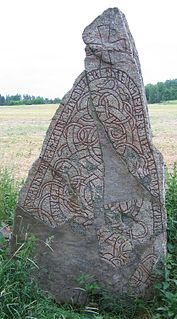 W
WBlot-Sweyn (Swedish:Blot-Sven) was a Swedish king c. 1080, who replaced his Christian brother-in-law Inge as King of Sweden, when Inge had refused to administer the blóts at the Temple at Uppsala. There is no mention of Sweyn in the regnal list of the Westrogothic law, which suggests that his rule did not reach Västergötland. According to Swedish historian Adolf Schück he was probably the same person as Håkan the Red and was called the Blót Swain as an epithet rather than a personal name.
 W
WThe decline of Greco-Roman polytheism, also sometimes referred to as the decline of paganism in the Roman Empire, according to a long established theory, began as a slow process in the second to first century BC, then sped up dramatically in the fourth century AD, producing paganism's catastrophic collapse in the fifth century AD. Both the slow decline of paganism, and the catastrophic demise of paganism afterwards in Late Antiquity, became disputed in the late twentieth century. Modern scholarship sees the traditional public cults as remaining vibrantly alive throughout the Hellenistic era and on into the period of empire. Defining Late Antiquity by its social, cultural and religious themes has allowed that period to be seen as a period of creative change, rather than decline, that lasted into the seventh century. In debates over the nature of Late Antiquity, a political model still champions the view of rupture, whereas a religious theme insists this process was a metamorphosis with a basic continuity rather than drastic collapse. People moved from "religion embedded in the city-state" to "religion as a choice".
 W
WJulian was Roman emperor from 361 to 363, as well as a notable philosopher and author in Greek. His rejection of Christianity, and his promotion of Neoplatonic Hellenism in its place, caused him to be remembered as Julian the Apostate in Christian tradition.
 W
WThe pagan reaction in Poland was a series of events in the Kingdom of Poland in the 1030s that culminated in a popular uprising or rebellion, or possibly a series of these, that destabilized the Kingdom of Poland.
 W
WSaint George's Night Uprising in 1343–1345 was an unsuccessful attempt by the indigenous Estonian population in the Duchy of Estonia, the Bishopric of Ösel-Wiek, and the insular territories of the State of the Teutonic Order to rid themselves of Danish and German rulers and landlords who had conquered the country in the 13th century during the Livonian Crusade; and to eradicate the non-indigenous Christian religion. After initial success the revolt was ended by the invasion of the Teutonic Order. In 1346, the Duchy of Estonia was sold for 19,000 Köln marks by the King of Denmark to the Teutonic Order. The shift of sovereignty from Denmark to the State of the Teutonic Order took place on November 1, 1346.
 W
WQuintus Aurelius Symmachus "Eusebius" was a Roman statesman, orator, and man of letters. He held the offices of governor of proconsular Africa in 373, urban prefect of Rome in 384 and 385, and consul in 391. Symmachus sought to preserve the traditional religions of Rome at a time when the aristocracy was converting to Christianity, and led an unsuccessful delegation of protest against Gratian, when he ordered the Altar of Victory removed from the curia, the principal meeting place of the Roman Senate in the Forum Romanum. Two years later he made a famous appeal to Gratian's successor, Valentinian II, in a dispatch that was rebutted by Ambrose, the bishop of Milan. Symmachus's career was temporarily derailed when he supported the short-lived usurper Magnus Maximus, but he was rehabilitated and three years later appointed consul. After the death of Theodosius I, he became an ally of Stilicho, the guardian of emperor Honorius. In collaboration with Stilicho he was able to restore some of the legislative powers of the Senate. Much of his writing has survived: nine books of letters; a collection of Relationes or official dispatches; and fragments of various orations.
 W
WThe Vata pagan uprising was a Hungarian rebellion which, in 1046, brought about the overthrow of King Peter Urseolo, the martyrdom of Bishop Gerard of Csanád and the reinstatement of the Árpád dynasty on the Hungarian throne.